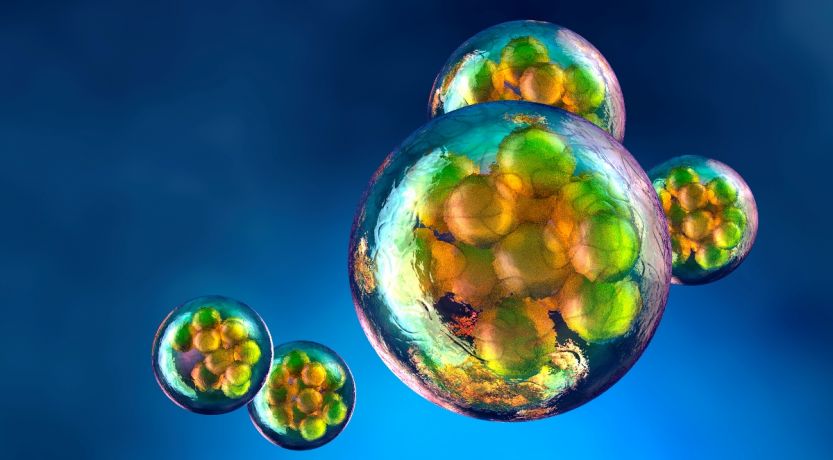One of the most important questions in life is whether there is a God who created us and has a plan for us. Here are some interesting and important factors to consider.

When we look at the physical world around us, we see beauty, complexity and design everywhere. Yet evolutionists try to explain the physical creation without a Designer.
This article discusses evidence that God is the great Designer.
1. Origin—cause and effect
In the physical world, we recognize that when something happens, there has to be a cause. When a house burns down, investigators look throughout the remains to find the cause. The cause perhaps might be faulty wiring or a heater that was not working properly.
The physical universe exists. How did it start? Why do we find complexity and beauty in this universe we live in?
When we find something like an old rusted-out car in the desert, no one doubts that it was designed. We all understand that there must have been a designer who made the plans needed to build this car. Yet if we find a living creature in the desert, many will say that it was not designed. It evolved by accidental variations in the genes—by blind chance.
Yes, many scientists today claim living creatures evolved by chance, but the old car, which is much less complex than any living creature, was made by design.
The very existence of this beautiful planet we live on implies that there is a cause. It also implies there must be some reason we were created.
The question then arises: What is the cause of the universe, the galaxies and the earth?
2. The first cell
When the theory of evolution started to be widely accepted, the incredible complexity of all forms of life was not understood as well as it is today. Many still believed in spontaneous generation of life.
The famed scientist Louis Pasteur argued with many who believed that life came about spontaneously. Britannica.com says:
“In 1859, the year English naturalist Charles Darwin published his On the Origin of Species, Pasteur decided to settle this dispute. He was convinced that his germ theory could not be firmly substantiated as long as belief in spontaneous generation persisted. Pasteur attacked the problem by using a simple experimental procedure. He showed that beef broth could be sterilized by boiling it in a ‘swan-neck’ flask, which has a long bending neck that traps dust particles and other contaminants before they reach the body of the flask. However, if the broth was boiled and the neck of the flask was broken off following boiling, the broth, being reexposed to air, eventually became cloudy, indicating microbial contamination. These experiments proved that there was no spontaneous generation, since the boiled broth, if never reexposed to air, remained sterile. This not only settled the philosophical problem of the origin of life at the time but also placed on solid ground the new science of bacteriology, which relied on proven techniques of sterilization and aseptic manipulation.”
Pasteur showed that life came only from preexisting life. This was a very important advancement in science.
Today we know even a single-celled life-form has an amazing amount of complexity (see “Origin of Life: Are Single Cells Really Simple?”). Every single cell is a marvelous example of design. Yet, sadly, today many scientists believe that life began in an ancient pond that had the right conditions. No one has ever been able to replicate this feat today.
3. Symbiosis
There are some amazing examples of symbiosis—the close interaction of two species—in the biological world.
One of the most amazing examples is the relationship between sharks and some small remora fish. The sharks need to have their teeth cleaned, and they allow these small fish to go into their mouth and clean them.
This is an example of a function that has to work perfectly the first time. How does the shark know that this particular fish will clean its teeth? How does the fish learn that cleaning the shark’s teeth will not end up in instant death? This is very difficult to explain using natural selection without a Designer.
4. The laws of nature
We are told by evolutionists that there is no evidence of a Creator. Everything can be explained by chance. However, they take for granted very important aspects of the universe.
If the physical universe were the product of chance, then the matter, energy and laws of the universe would have had to develop by chance as well, out of nothing!
If the physical universe were the product of chance, then the matter, energy and laws of the universe would have had to develop by chance as well, out of nothing!
If it all happened by chance, why assume that what we see as laws would be constant throughout the universe? Why would the forces and constants we detect be exactly suited for life?
The laws of the universe are fine-tuned to allow us to live. For example, according to Focus.org.uk: “The strength of the force of gravity is a specific example of cosmic fine-tuning. If gravity was much stronger than it is, complicated creatures like human beings could not exist.
“The important point is how the strength of gravity compares with the strength of the electrostatic force. This is the force that operates between things that have electric charges. It holds electrons in their orbits in atoms, and it is responsible for the chemical bonds between atoms. …
“We can imagine a universe in which the force of gravity was repulsive rather than attractive. Things would fly apart, rather than falling towards each other. In such a universe you would not get galaxies or stars or planets. In fact, it’s very difficult to imagine any kind of complicated structure (such as a plant or an animal) in a universe without some kind of force pulling things together on a large scale.”
5. Perfection
In order for a complex system to function properly, everything must be properly designed and in good working order. You may have a beautifully designed car, yet if a wire to the battery is disconnected, the car will not work. Everything must work together, or the car will not run.
Michael Denton, in his book Evolution: A Theory in Crisis, has a whole chapter called “The Puzzle of Perfection.” He states: “The intuitive feeling that pure chance could never have achieved the degree of complexity and ingenuity so ubiquitous in nature has been a continuing source of scepticism ever since the publication of the Origin. … In fact, the number of biologists who have expressed some degree of disillusionment is practically endless” (1986, p. 327).
Darwin had even expressed doubts about how the eye could have been created by evolution. “In a letter to Asa Gray, the American biologist, written in 1861, just two years after the publication of the Origin of the Species, he acknowledges these doubts and admits that ‘The eye to this day gives me a cold shudder’” (p. 326).
The human eye is unbelievably complex. Biologist and zoologist Alan L. Gillen praised the design of the human retina in his book, Body by Design:
“The most amazing component of the camera eye is its ‘film,’ which is the retina. This light-sensitive layer at the back of the eyeball is thinner than a sheet of plastic wrap and is more sensitive to light than any man-made film. The best camera film can handle a ratio of 1000-to-1 photons in terms of light intensity. By comparison, human retinal cells can handle a ratio of 10 billion-to-1 over a dynamic range of light wavelengths of 380 to 750 nanometers. The human eye can sense as little as a single photon of light in the dark! In bright daylight, the retina can bleach out, turning its ‘volume control’ way down so as not to overload. The light-sensitive cells of the retina are like an extremely complex high-gain amplifier that is able to magnify sounds more than one million times” (2001, pp. 97-98).
The amount of information that the eye sends to the brain is amazing! Millions of bytes of information must be transmitted to the brain. Science writer Ker Than wrote on Livescience.com:
“The researchers calculate that the 100,000 ganglion cells in a guinea pig retina transmit roughly 875,000 bits of information per second. The human retina contains about 10 times more ganglion cells than that of guinea pigs, so it would transmit data at roughly 10 million bits per second, the researchers estimate.
“This is comparable to an Ethernet connection, which transmits information between computers at speeds of 10 million to 100 million bits per second.”
Notice the incredible amount of information the eye sends to the brain. Would anyone ever say that a computer evolved by itself and by chance sends this amount of information?
The Bible reveals how incomprehensible God’s creation is:
“Many, O LORD my God, are Your wonderful works which You have done; and Your thoughts toward us cannot be recounted to You in order; if I would declare and speak of them, they are more than can be numbered” (Psalm 40:5).
Consider outer space. Who cannot be inspired by going out at night and seeing the moon and stars?
“When I consider Your heavens, the work of Your fingers, the moon and the stars, which You have ordained, what is man that You are mindful of him, and the son of man that You visit him?” (Psalm 8:3-4).
We live in such a vast universe that scientists still have not found the edge of it. This again shows the veracity of the Bible and is a proof of the existence of the unlimited God. When we see the universe, we realize how small we are compared to what God has created.
When you look honestly at nature and the incredible complexity and design that is demonstrated by the creation, the obvious conclusion is that we live in a world designed by an ingenious Designer!





